Kevin Kjoller, Craig Prater and Roshan Shetty, !%Anasys Instruments Corp.%!
The phrase “lab on a tip,”
referring to nanoscale property measurements made by the probe of an atomic force
microscope (AFM), has been a dream for the developers of analytical instrumentation.
There also has been a drive for “hyphenated techniques” that make multiple
types of complementary measurements simultaneously. This has been driven with investment
in nanotechnology in many fields, notably in the materials and life sciences, especially
for studies that correlate structure and property or function. Looking at a polymer
company, one sees that many analytical techniques are used, with infrared spectroscopy
and thermal analysis being two of the most common. However, the resolution of such
“macro” techniques will not explain behavior on length scales less than
1 µm. For example, how do polymers behave at the domain level; e.g., on the scale
of 100 nm?
The solution has been provided with nanoIR technology from Anasys
Instruments Corp., which overcomes the major barriers in AFM and conventional IR
spectroscopy (Figure 1). AFM has outstanding resolution on the nanoscale but cannot
perform chemical spectroscopy. IR spectroscopy has been the benchmark tool for chemical
characterization but has lacked the spatial resolution to address nanoscale problems.
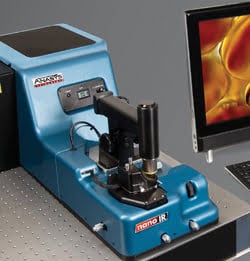
Figure 1. Anasys Instruments Corp.’s nanoIR system.
In addition to revealing chemical composition, the nanoIR system
provides high-resolution characterization of local topographic, mechanical and thermal
properties. This new tool will help facilitate materials and life sciences research
at the nanoscale.
The nanoIR system combines the nano-scale spatial resolution capabilities
of AFM with IR spectroscopy’s ability to characterize and identify chemical
species. Users of nanoIR technology can quickly survey regions of a sample via AFM
and then rapidly acquire high-resolution chemical spectra at the selected regions.
The system also can be programmed to automatically acquire spectra from an array
of points across the sample. Mechanical and thermal properties, such as local thermal
transitions, also may be mapped with nanoscale resolution.
How does nanoIR work?
The science behind the system applies the patent-pending technology
of photo-thermal induced resonance, a technique pioneered by Dr. Alexandre Dazzi
of the Laboratoire de Chimie Physique at the Université de Paris-Sud in Orsay,
France. The nanoIR system uses a pulsed, tunable IR source to excite molecular absorption
in a sample that has been mounted on a ZnSe prism. Samples are prepared in one of
two ways. For many samples, ultramicrotomy is used to cut sections with thicknesses
between 100 and 1000 nm. These are then transferred to the prism surface. In other
sample preparations, it is possible to cast thin films from solvent directly onto
the prism.
The IR beam illuminates the sample by total internal reflection
similar to conventional attenuated total reflection spectroscopy (Figure 2). As
the sample absorbs radiation, it heats up, leading to rapid thermal expansion that
excites resonant oscillations of the cantilever, which are detected using the standard
AFM photodiode measurement system. These induced oscillations decay in a characteristic
ringdown, which can be analyzed via Fourier techniques to extract the amplitudes
and frequencies of the oscillations. Then, by measuring the amplitudes of the cantilever
oscillation as a function of the source wavelength, local absorption spectra are
created.
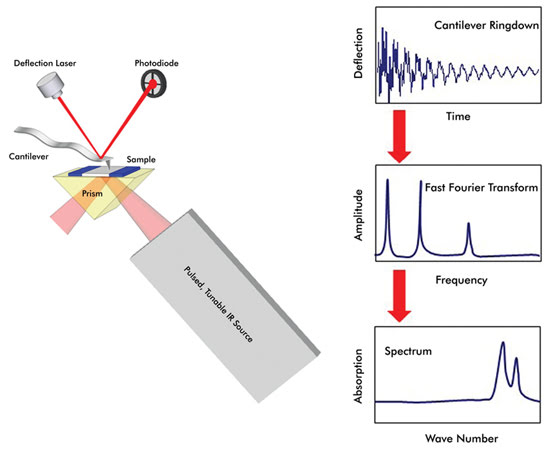
Figure 2. The basic principles of the nanoIR technology.
The oscillation frequencies of the ringdown also are related to
the mechanical stiffness of the sample. With maximum flexibility, the IR source
can also be tuned to a single wavelength to simultaneously map surface topography,
mechanical properties and IR absorption in selected absorption bands.
At work with nanoIR
Potential application areas for nanoIR are broad. They include
polymer blends, multilayer films and laminates, organic defect analysis, tissue
morphology and histology, subcellular spectroscopy and organic photovoltaics. Polymer
spectra acquired with the nanoIR system are rich and interpretable, and they have
demonstrated good correlation with bulk Fourier transform infrared spectra. The
nanoIR software allows researchers to export nanoscale IR absorption spectra to
standard analysis packages. With this interface, nanoIR spectra can be used to rapidly
analyze samples and identify specific chemical components.
Integrated measurements that permit the user to see multiple results
from a single sample from one instrument platform are very beneficial. This power
is well illustrated in this landmark example of a nylon-ethylene acrylic acid composite.
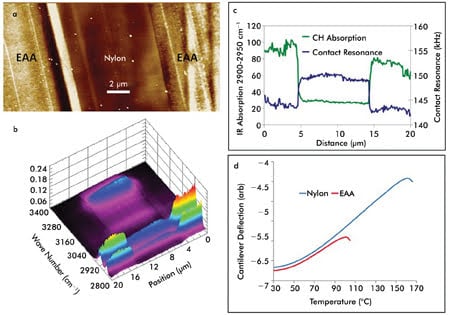
Figure 3. (a) A high-resolution AFM image shows the topography of a composite sample comprising
nylon and ethylene acrylic acid (EAA). (b) The composite of chemicals characterized
by nanoscale IR spectroscopy. (c) The mechanical properties of the composite are
mapped at the nanoscale. (d) Local transition temperatures are reported through
nanothermal analysis.
In Figure 3, four data sets are shown. Figure 3a shows a familiar
high-resolution AFM image that provides the topography of the surface of the material.
This contrast image shows stripes of the component polymers. Figure 3b shows the
chemical characterization by nanoscale IR spectroscopy – measured by photothermal
induced resonance. Figure 3c illustrates nanoscale mechanical property mapping measured
by contact resonance, and Figure 3d shows local transition temperatures reported
through nanothermal (nanoTA) analysis, which is analogous to the macro thermomechanical
analysis.
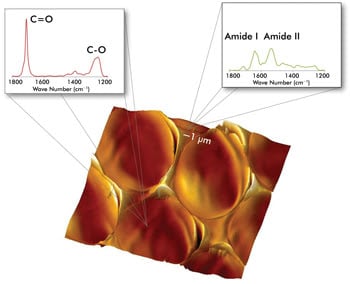
Figure 4. A nanospectroscopic examination of a polyethylene terephthalate-nylon composite.
A further example is of a polyethylene terephthalate-nylon composite
(Figure 4). Here, by highlighting individual components, the spectroscopy data is
examined more closely. Biodegradable polymers are important materials in a variety
of applications ranging from tissue engineering, drug delivery and food packaging
to textiles. Such materials are increasingly complex blends of base materials and
performance-enhancing additives. The nanoIR system has been used to map, characterize
and even identify specific polymer additives.
The data in Figure 5 shows the spectral mapping of a biodegradable
polymer blend. AFM measurements allow spatial mapping of polymer matrix and additives.
The nanoIR can then spatially map variations in chemical components. In the spectral
line map (right), note the spatially varying concentration of the C=O carbonyl band
(1740 cm–1) and the single-bond C-O peak at around 1100 cm–1.
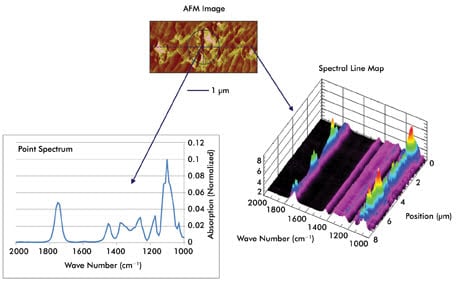
Figure 5. Spectral mapping of a biodegradable polymer blend.
More power for analysis
Leading scientists have offered their thoughts on the use and
potential of nanoIR. President-elect of the Society of Applied Spectroscopy and
a retired research fellow from Procter & Gamble, Dr. Curtis Marcott, said that
IR micro-spectroscopy has already proved itself extremely valuable for addressing
a wide range of problems in science and industry. He said he is excited over the
new nanoIR technology because it will allow scientists to break through the submicron
spatial resolution barrier and apply IR spectroscopy to new classes of problems
beyond current capabilities.
Dr. Katherine (Kallie) Willets, an expert in nanomaterials spectroscopy
and microscopy at the University of Texas at Austin, was quoted in Chemical &
Engineering News following Pittcon (March 29, 2010, Vol. 88, No. 13). She said,
“By far, the product that excited me most in molecular spectroscopy was the
nanoIR from Anasys Instruments. This system combines the rich vibrational information
of IR spectroscopy with the high-resolution imaging offered by atomic force microscopy.
The instrument’s ability to measure IR absorption spectra from nanoscale regions
of a sample is extremely exciting and opens up new avenues for nanoscale characterization
using vibrational spectroscopy.”
In the literature, several new papers have shown how the developers
continue to identify new and exciting applications. A selection is provided below.
This all goes to underscore the value of this exciting new technique, nanoTA.
Acknowledgments
The nanoIR system is the result of several million dollars of
government and private investment. Anasys Instruments was awarded $2.6 million in
research grants from the NIST Advanced Technology Program and the National Science
Foundation. US and foreign patents are pending.
Further reading
C. Mayet et al (2010) In situ identification and imaging of bacterial
polymer nanogranules by infrared nanospectroscopy. Analyst, pp. 2540-2545.
A. Dazzi et al (2010). Theory of infrared nano-spectroscopy by
photothermal induced resonance. J Appl Phys, p. 124519.
K. Kjoller et al (2010). High-sensitivity nanometer-scale infrared
spectroscopy using a contact mode microcantilever with an internal resonator. Nanotechnology,
p. 185705.
J. Houel et al (2009). Mid-IR absorption measured at lambda/400
resolution with AFM. Opt Exp, pp. 10887-10894.
Meet the author
Roshan Shetty is the chief executive officer of Anasys Instruments;
e-mail: [email protected]